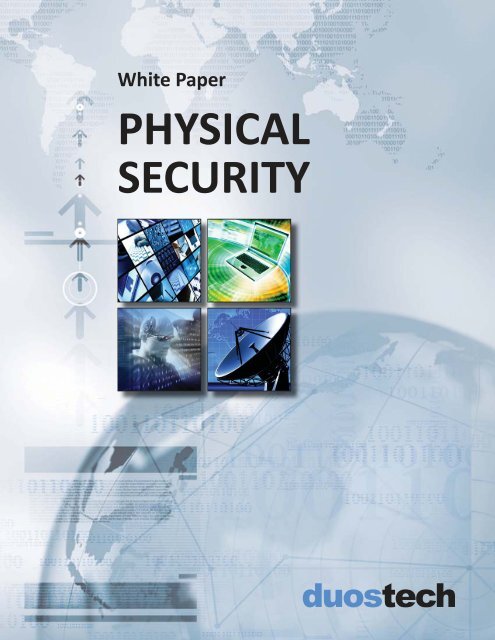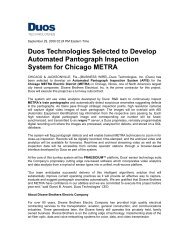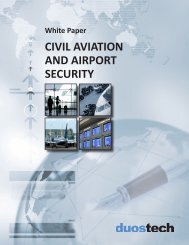physical security white paper - Duos Technologies
physical security white paper - Duos Technologies
physical security white paper - Duos Technologies
- No tags were found...
Create successful ePaper yourself
Turn your PDF publications into a flip-book with our unique Google optimized e-Paper software.
White PaperPHYSICALSECURITY
<strong>Duos</strong> <strong>Technologies</strong>, Inc.PHYSICAL SECURITYWHITE PAPERBYCHARLES GOSLIN“Charles Goslin, Vice President of International Operations for <strong>Duos</strong> <strong>Technologies</strong>, Inc., is aninternational expert in <strong>security</strong> threat and risk assessment. He developed his extensive <strong>security</strong>experience as a veteran operations officer for 27 years with the Central Intelligence Agency. He isskilled in developing and executing programs targeting terrorism, espionage, weaponsproliferation, and other select U.S. national <strong>security</strong> objective. He brings a unique, ground-levelperspective to <strong>security</strong> challenges that can only come from a lifetime spent mitigating risk, in all itsforms, while living and working abroad.His most recent assignment, before joining <strong>Duos</strong>, was as a senior advisor to the Regional JointTerrorism Task Forces (JTTF) in the U.S. In addition to Mr. Goslin’s current work with internationalclients, he has authored professional articles and undertaken public speaking engagementsregarding the evolution of <strong>physical</strong> <strong>security</strong> in the 21 st century, and how it can better secure criticalinfrastructure for public and private enterprise.”
<strong>Duos</strong> <strong>Technologies</strong>, Inc.THIS PAGE INTENTIONALLY LEFT BLANKPage 2 of 8 PHYSICAL SECURITY 12/11/2008
<strong>Duos</strong> <strong>Technologies</strong>, Inc.political motives and objectives which they wanted satisfied, and that they prefer to stay alive toensure these goals are achieved. Airline hijackers are expected to have demands, such as forprisoner release, money, as well as an escape route. The tactic most often anticipated is infiltrationof bad things: of the terrorist and a gun, the terrorist and an explosive (hidden on his person, orin/under a vehicle), or both. Professional intruders, unintimidated by guards, locks, and barriers,are expected to infiltrate a facility to commit sabotage, steal secrets or valuables, and escape –undetected. Evidence of these assumptions lie with the <strong>security</strong> tools chosen by <strong>security</strong>practitioners.Using an extension of this flawed logic, detection or deterrencetechnology is selected that focuses on identifying bad things atcheckpoints, or detecting the unauthorized person who has gotteninto the facility itself. Motion detection sensors remain confinedlargely to interior spaces as outdoor detection sensors wereconsidered too vulnerable to environmental factors and susceptibleto nuisance alarms. CCTV’s, theoretically capable of detectingincidents in real-time so long as an alert human is watching, are stillused only as a deterrence measure, and for post-incident analysis andinvestigation. There is also an overreliance on magnetic-swipe accesslocks and/or code-entry pads, as systems that could “log” anindividual’s entry and exit, without corresponding authenticationmeasures for verification. Combination locked vaults are susceptibleto the same vulnerability – unverified, surreptitious entry.Time and again in recent years, overreliance on identifying vulnerability within the <strong>security</strong>-indepthdesign results in fatal flaws—in every sense of the word. Attackers no longer hide bombsunder their vehicles or in the boot of a car; they fill every conceivable space with explosivematerial, wire the detonators to their chests, throw grenades as diversionary measures, and ramthemselves and their lethal load as far into the premises of a facility as possible, at top speed,before detonating themselves. In their wake, are twisted and smoking bollards, barriers, fences,cameras, injured or dead guards with unused – expensive – explosives detection wandssomewhere beneath the rubble. Clearly, this is a failed application of a design that emphasizes thedetection of the explosive or gun, and not detecting – in time – the terrorist behavior itself. It is agood countermeasure, but designed for a different set of circumstances.As we have seen in London, and more recently in Islamabad,and Mumbai, the CCTV cameras accurately and faithfullycaptured the faces of attackers, or the final seconds of a truckbomber’srun. These high-definition, day-night sophisticatedcameras impassively detected the targets. However, since –within the existing <strong>security</strong> design – the CCTV cameras wererelegated to roles as passive recording devices, they did nothingto alert in real-time or deter the attacks themselves. In London,we posthumously got to know the identities of the attackers,where they came from, and a little about their motives, and neighbors. These interesting facts,though, did little to help those killed or wounded in the attack.Page 4 of 8 PHYSICAL SECURITY 12/11/2008
<strong>Duos</strong> <strong>Technologies</strong>, Inc.Within the U.S. Pentagon, in U.S. National Labs, or most recently in the White House itself – themost sophisticated mechanical or intrusion detection measures available do not deter innovative,relentless intruders adept at manipulating human weaknesses, or IT vulnerabilities, fromthousands of miles away, to get at our nation’s most sensitive secrets. The information highway isbroad, invisible and largely bypasses all of the <strong>physical</strong> <strong>security</strong> countermeasures designed tosequester cleared personnel, working at “cleared” computer terminals. Retrospectively, <strong>security</strong>in-depth is a classic design formula that favors the abstraction of “threat” and focuses instead onvulnerability; closing the vulnerabilities translates to mitigation of risk. Threat, when misappliedwithin this philosophy, remains in varying degrees a slowly evolving, amorphous entity that is justnot in synch with rapidly changing circumstances.Good Technology, poor designArtist Rendering of <strong>Duos</strong> UVMSFor instance, Under-Vehicle Monitoring Systems(UVMS)—an excellent countermeasure to detectconcealed explosives beneath a truck or car—cannot be the panacea for bomb detection at thegateway to a facility. It must be integrated withother explosive-detection technologies, designed towork in conjunction with robust barrier technologyand not used as a substitute for measures to identify and neutralize vehicular (VBIED) bombthreats from outside the perimeter. In a design that takes into consideration today’s threatenvironment, UVMS systems are at best a secondary, and not the primary detectioncountermeasure for explosives. CCTV cameras in tough, armored, air-conditioned housings, withhigh-definition, day-night capabilities, are of little or no use when they convey so many images tothe latest plasma flat-screen monitor in the Command and Control Center that overwhelmed,under-paid shift-workers stop watching. Metal detectors and explosives sniffers are incapable ofdetecting or deterring human desperation and will themselves become so much scrap metal if thesuicide bomber detonates him/herself. The latest magnetic-swipe ID system is of no use at all if thebadge is stolen or acquired outside of the facility, and used by the intruder. The point is thatcontinuing to design in-depth <strong>security</strong> with a focus on vulnerabilities and detection of bad thingsonly perpetuates the illusion of good <strong>security</strong>. This brings us to the convergence of IT and <strong>physical</strong><strong>security</strong> disciplines.Giving threat its due: Convergent Design and TacticsSecurity practitioners who interpret in-depth <strong>physical</strong> <strong>security</strong> with a threatdriven,“outside-in” design must of necessity give greater consideration tothe specific tactics employed by today’s terrorist adversaries. These tacticsinclude suicide bombings, as well as clandestine, armed teams infiltrating ahotel or resort to take hostages and inflict as much mayhem as possible.Traditional <strong>security</strong> design can be coupled with convergent IT and <strong>security</strong>technologies and applications to significantly strengthen the existing<strong>security</strong> investment because equal weight is given to designing for specific,current threat scenarios.Page 5 of 8 PHYSICAL SECURITY 12/11/2008
<strong>Duos</strong> <strong>Technologies</strong>, Inc.An illustration of this is standard perimeter <strong>security</strong>. Perimeter <strong>security</strong> is usually considered theoutermost ring of “<strong>security</strong> in depth,” which follows a deterrence-through-design methodologythat includes fences or walls, bollards, barriers, cameras, height-detectors at the gates, andlighting. The deterrent element of this design is presumed to be frustration or intimidation of thetrivial (petty criminal looking for an easy way in), and delay of the serious (professional criminal, orterrorist infiltrator with an agenda). Using a threat-driven perspective, and taking into accounttoday’s terrorist tactics, two additional needs for perimeter <strong>security</strong> immediately becomeparamount: real-time detection, and real-time – immediate - assessment of the threat. Simplyusing the technologies outlined above, even with a well-trained guard force, is not sufficient. Onthe other hand, using a network of robust, day-night fixed outdoor cameras, tied to long-rangePan-Tilt-Zoom cameras, enabled with a video intelligent-application, we have a marriage ofIT/convergence technology with <strong>physical</strong> <strong>security</strong> measures that, by an order of magnitude,strengthens the perimeter.The intelligence-enabled camera network on the fence-line detectsand sends an alert about an approaching threat, in real time. Thisgives <strong>security</strong> personnel the time needed to assess and take actionto neutralize or avoid the threat before it becomes a liability toeveryone in the subject facility. On seaward facing properties, theperimeter can be secured using a virtual electronic “bubble” of<strong>security</strong> can secure approaches out to 12-kilometers, using groundbasedradar and all-weather, day-night, laser illuminated PTZcameras integrated to automatically vector-in, and track onapproach unknown targets.Significant standoff distance can be achieved using this technologyby using the space outside of the perimeter, not just between theperimeter and the facility itself. With intelligent video and sensorapplications, a dumb perimeter can be transformed from a <strong>physical</strong>“deterrence-through-design” countermeasure to an interactivevirtual barrier with depth that can actually allow real-time denial of lethal attackers. In thisapplication, the CCTV camera array is transformed from being a deterrent or investigative tool to areal-time intrusion-detection and assessment tool providing advance alerts that allows <strong>security</strong>time to react, save guest and employee lives, and secure valuable property and assets.Addressing the threat of the InsiderArtist Rendering of Border SecurityUsing convergent technologies within the perimeter, the“insider” threat can be addressed, head-on. Once insidesensitive areas, electro-mechanical entry technology such asmagnetic swipe access can be augmented by facialgeometry/recognition or biometric access applications thatprovide the crucial authentication needed to verify accessinto sensitive areas. Insider-enabled clandestine access into sensitive areas is significantly reducedusing convergent technology to supplement traditional locks and alarms. In public transitchokepoints, rapidly developing facial recognition software technology, scanning for known threatPage 6 of 8 PHYSICAL SECURITY 12/11/2008
<strong>Duos</strong> <strong>Technologies</strong>, Inc.profiles, can give law enforcement or national <strong>security</strong> authorities a real-time edge in detecting theproverbial “needle in a haystack.” Combined with live intelligence reports, even a 70-percentrecognition reliability factor helps analysts narrow the odds for police in the middle of a manhunt.Streamlining Command and ControlAn important shift in emphasis, when incorporating convergent IT/Security applications intooverall <strong>security</strong> design for the hospitality industry, is the Command and Control (C&C) Center andits operation. The application platform used to integrate intelligence-enabled sensors, cameras,and ground-radar, and the displays used topresent the information to the operators, mustbe significantly upgraded from the traditional<strong>security</strong> operations center used to directoperations. In the old C&C Center design, displaymonitors use sequential CCTV switchers, rotatingthrough potentially hundreds of CCTV camerasand showing them as multiple camera scenes ona single monitor… with perhaps a dozen or moremonitors in the room. This is illusory <strong>security</strong>; inreality, no operator can reliably focus on thescenes displayed for a significant amount oftime.Command and Control CenterConvergent IT/Security transforms the natureand utility of the C&C Center. Using intelligentvideo, monitors can be replaced by flat videowalls that can be used to display Internet screensand video-enabled conference calls, as well asthree-dimensional displays of the facility and itsenvironment. Gone are multiple camera scenes –they are no longer needed. With the CCTVcamera activated as a sensor/detection device,enabled by a robust, server-based applicationcentralized within a hardened equipment room,a video display comes up only when the cameradetects an intrusion and an alarm is sent to theC&C Center. On a three-dimensional (3D) displayof the facility (inside and out), the location of theintrusion and camera field of view (FOV) glowsred; only then does the operator need to react,bring up the display, and – using a Pan-Tilt-Zoom(PTZ) in the vicinity – investigate and assess thethreat, in real time. Sophisticated intelligent video software will detect and generate alerts formultiple alarms and prioritize them. In this way, a <strong>security</strong> crisis can be efficiently managed bytrained <strong>security</strong> personnel, much as a Combat Controller manages force-protection, or live battledevelopments within the Combat Control (C&C) room on a naval ship. This capability, with theSophisticated <strong>Duos</strong> 3D Graphical User Interface (GUI)Page 7 of 8 PHYSICAL SECURITY 12/11/2008
<strong>Duos</strong> <strong>Technologies</strong>, Inc.technology available today, enables <strong>security</strong> managers, guard force personnel on the perimeter,and first-responders to control crisis situations in the homeland just as efficiently.<strong>Duos</strong> <strong>Technologies</strong><strong>Duos</strong> <strong>Technologies</strong>, Inc. epitomizes the transformation taking placein convergent technologies and applications for today’s <strong>security</strong>market. We believe that careful design of <strong>security</strong> solutions, takinginto account existing measures, and the known threat environment,are an absolute requirement. We take a holistic approach to eachclient’s <strong>security</strong> needs and as a first step, require a full <strong>security</strong> andengineering assessment with equal emphasis on <strong>security</strong> threat aswell as vulnerability, before issuing a proposal. Our R&D team testsexisting technologies to assess their capabilities and suitability inour overall solutions. Commercially, we are a full-service integratorthat is lean and nimble enough to respond quickly and efficiently tolarge infrastructure <strong>security</strong> needs, at a fraction of the price quotedby our larger, but less agile, industry counterparts.Most important, <strong>Duos</strong> <strong>Technologies</strong> is composed of a team of dedicated <strong>security</strong> professionals whoare at the vanguard of cutting edge <strong>security</strong>, making intelligent video and sensor-basedtechnologies, and Command and Control software platforms, the new standard for <strong>security</strong> design.Page 8 of 8 PHYSICAL SECURITY 12/11/2008









